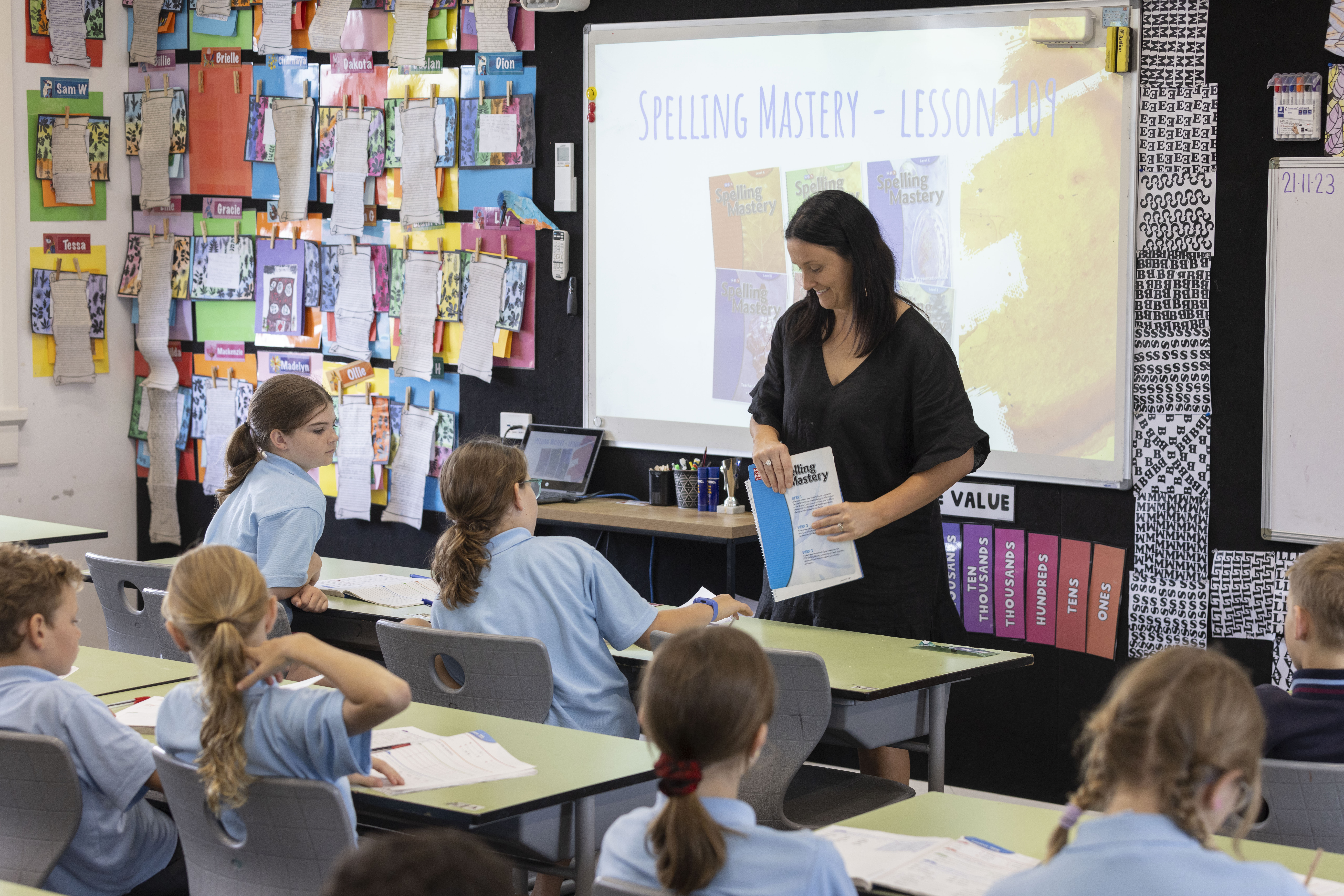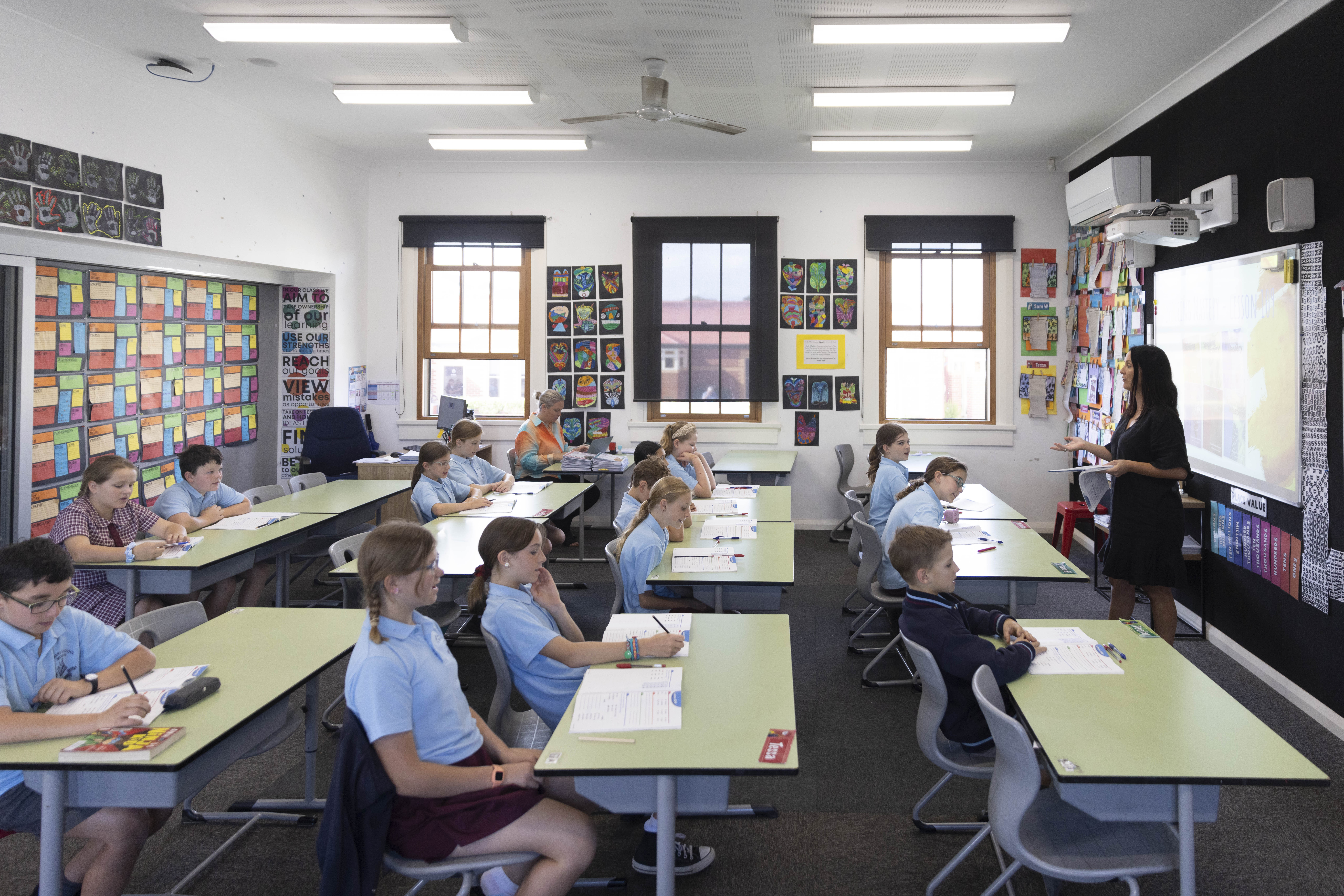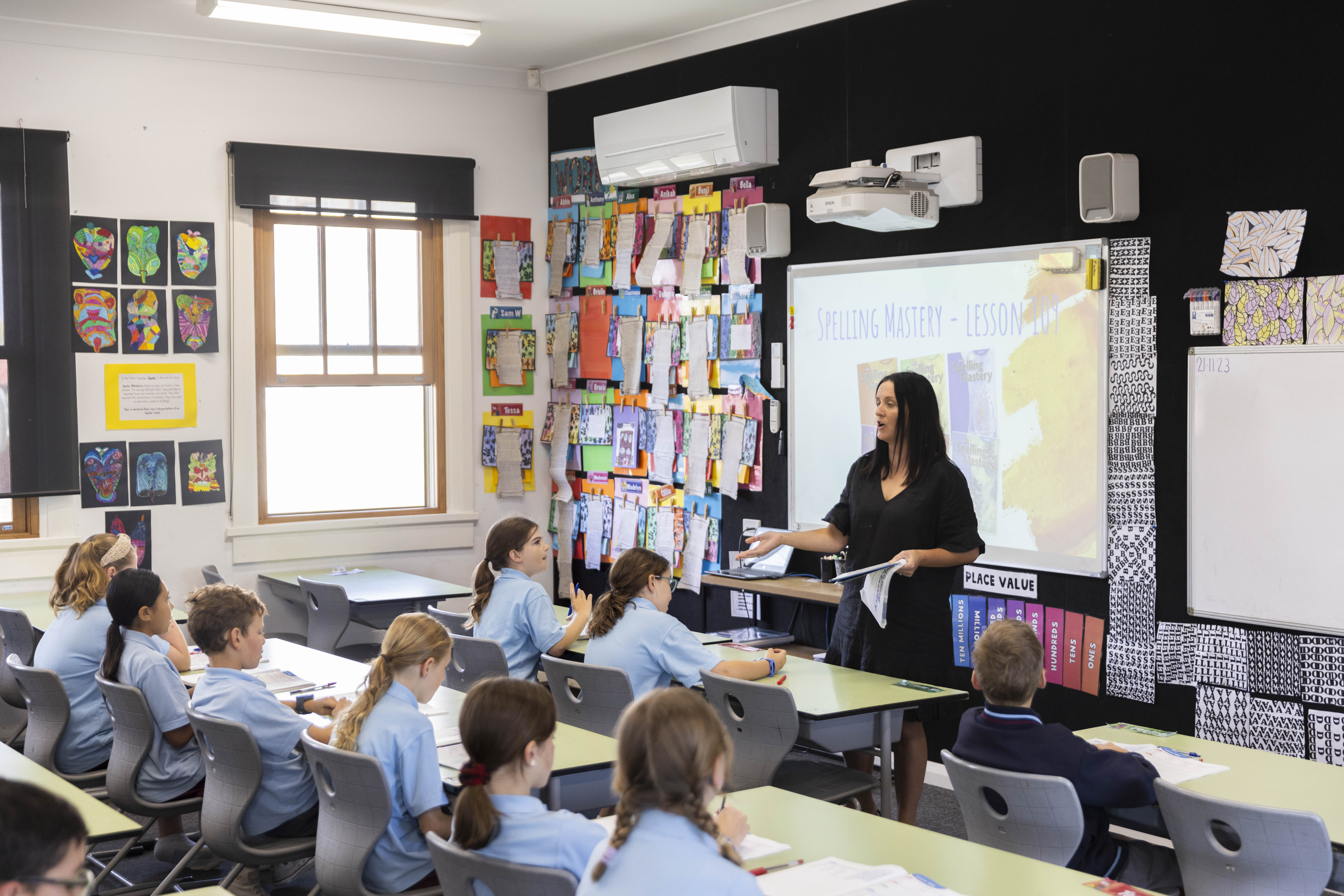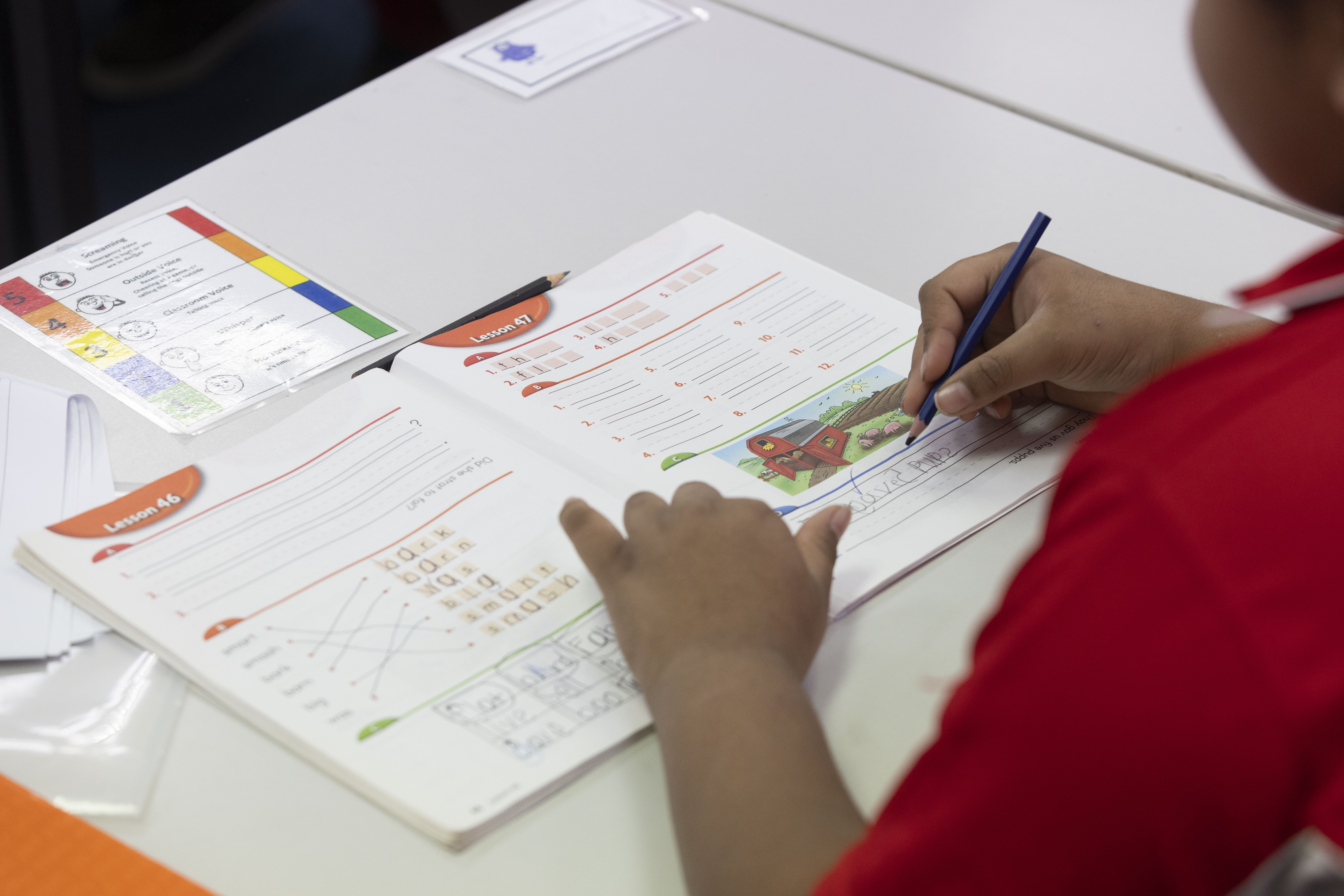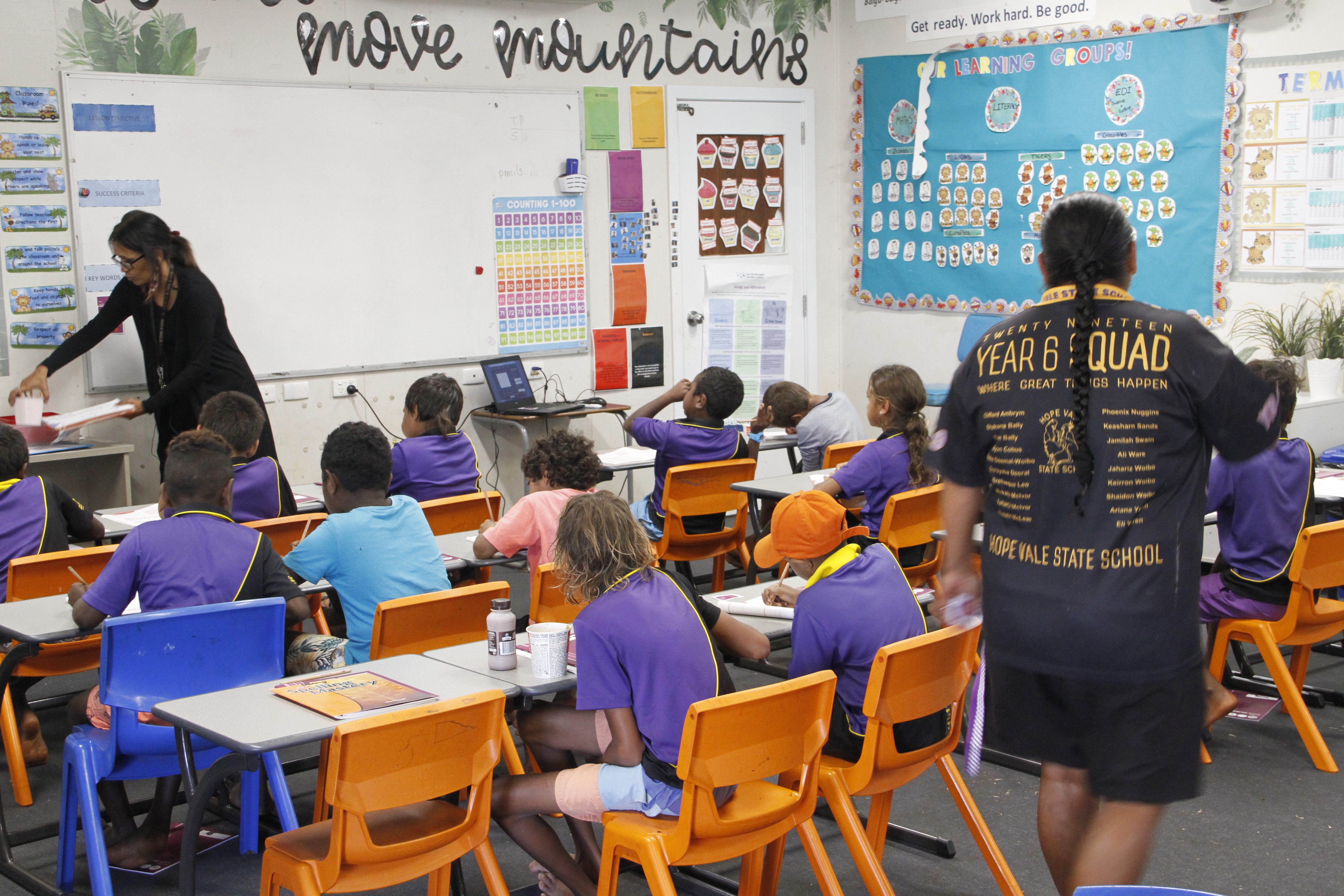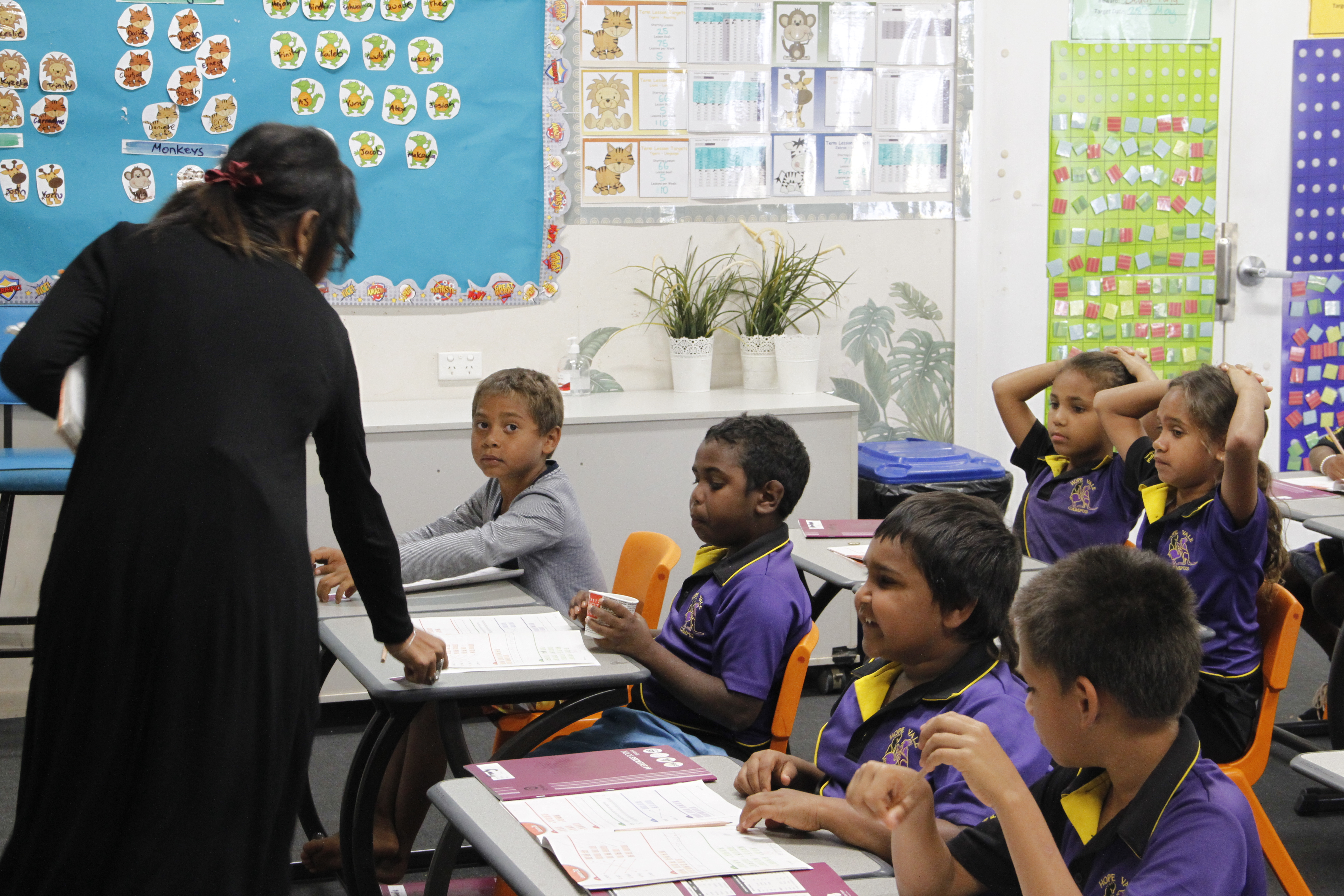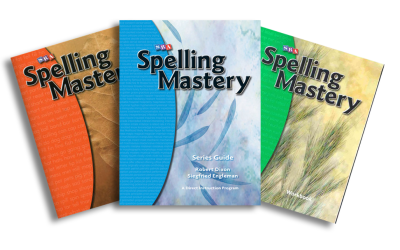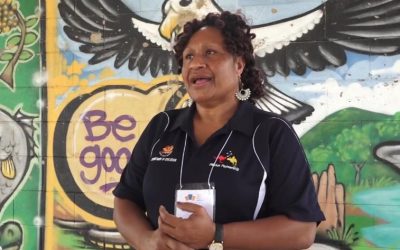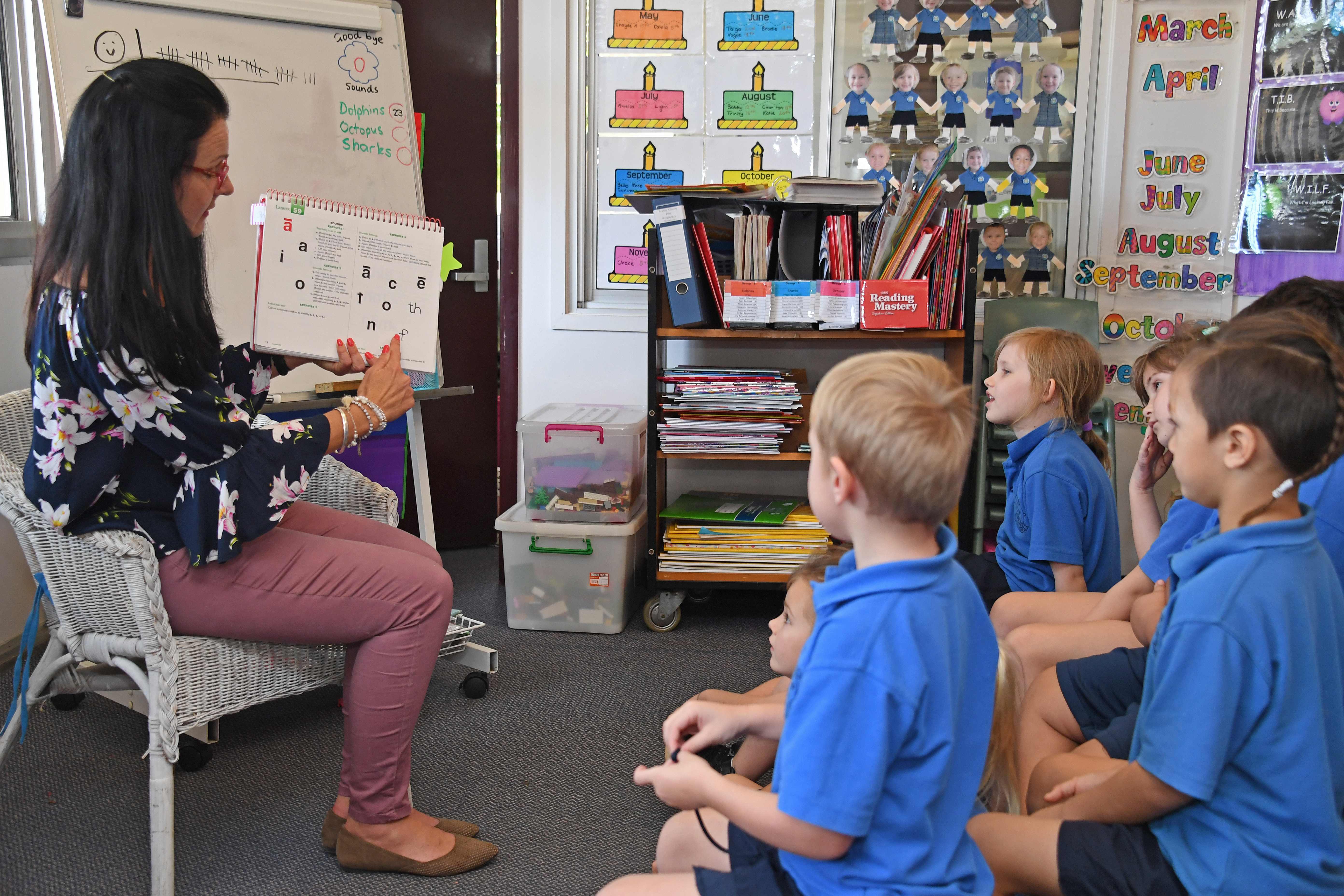Introduction
Are you a teacher struggling to engage your students in spelling lessons? Are your students not getting consistent results across the class? If so, you should consider using Spelling Mastery. In this article, we explore what Spelling Mastery is, its benefits, its teaching pedagogy, and which classrooms and schools can benefit from implementing this program.
Understanding the Basics of Spelling Mastery
Spelling Mastery is a meticulously crafted program aimed at enhancing the spelling proficiency of students. It operates on the foundational principle that mastery in spelling can be achieved through a structured and sequential approach, which introduces the multifaceted rules and patterns inherent in the English language. At its core, Spelling Mastery is not merely about rote memorisation of words but rather developing students’ deep understanding of spelling conventions so they can apply them to new and unfamiliar words they encounter.
The program has six levels (A to F), each designed to cater to the progressing abilities of students, thereby ensuring a personalised learning journey. This gradation facilitates a step-by-step exploration of the English language, starting from basic phonetic patterns to more complex morphological structures. By demystifying the complexities of spelling through explicit instruction, students are equipped with the tools to decipher words, bolstering their vocabulary, and simultaneously enhancing their language comprehension skills.
A pivotal component of Spelling Mastery is its emphasis on the application of knowledge. Students are regularly engaged in activities that not only consolidate their learning but also encourage the practical use of spelling rules in diverse contexts. This hands-on approach ensures that students are not passive recipients of knowledge but active participants in their learning process, which significantly contributes to the retention and application of spelling skills.
Moreover, Spelling Mastery acknowledges the inherent variability in student learning speeds and styles. It therefore uses a paced progression that aligns with each student’s individual learning trajectory. This flexibility is instrumental in cultivating an inclusive learning environment where every student – regardless of their initial spelling proficiency – has the opportunity to achieve mastery.
In essence, Spelling Mastery provides a comprehensive framework that empowers students to navigate the complexities of spelling with confidence. By instilling a deep-rooted understanding of spelling rules and fostering the application of these rules in varied contexts, Spelling Mastery sets the groundwork for lifelong literacy skills. Through its structured, sequential, and student-centred approach, Spelling Mastery champions both mastery and confidence in spelling.
How Spelling Mastery Lessons Are Delivered
Placement Tests
The first step is to determine which level of the program matches your students’ current instructional needs. To do this, you simply give them a series of short placement tests, with 10 words in each. When they get five or more words wrong, then you put them in that level.
Here is the procedure for administering placement tests:
- Give students the test that corresponds to their grade level. If students pass the grade-level test, give them the test for the next-highest level.
1a. Continue testing up a level until students don’t pass the test.
1b. If students fail the grade-level test, give them the test for the next lowest level. Continue testing down a level until students pass the test. - Record the highest level that each student passes on a summary spreadsheet.
- Group students into homogenous instructional groupings.
Lessons
Spelling Mastery can be implemented with individuals or whole classes. Spelling Mastery instruction is delivered in daily 15–20-minute sessions. Many teachers choose to start the day with a Spelling Mastery lesson.
The program has six levels (A to F), each with 60 to 120 lessons. Each level of Spelling Mastery provides a teacher presentation book, teacher/series guide student workbook and software.
In each lesson, teachers present an exercise, listen to student responses, and provide immediate feedback. Following an instructional sequence, teachers introduce sound-spelling relationships, morphographs (the smallest unit of meaning in written language), rules, and principles. Teachers integrate concepts cumulatively, with all strategies used and practices over time. Students’ progress is assessed using regularly scheduled tests.
The video below shows a real Spelling Mastery exercise where the students take individual turns.
Assessment and Reviews
Spelling Mastery contains two types of assessment: formal and informal. Formal assessments include:
- Placement Tests determine students’ instructional levels.
- End‐of‐Level or Criterion Tests may be used as a pre-test and post-test to show student achievement
- Regular Assessment—Bonus Activities and Optional Weekly Tests in Levels A and B and Spelling Tests in Levels C through F assess the words and skills students have been learning.
Spelling Mastery includes Standardised Test Preparation Materials to supplement the regular program. These tests give students practice in applying their spelling skills to standardised tests. In addition, there are informal assessments, such as Spelling Contests and Challenges, built into Spelling Mastery.
The video below shows a real Spelling Mastery test being administered to a class in Hope Vale Campus of the Cape York Aboriginal Australian Academy.
Placing Students into Ability-Based Groups
At Good to Great Schools Australia we recommend that schools delivering any Direct Instruction program (including Spelling Mastery) across multiple grades or schoolwide – placement test their students and organise them into ‘ability groups’ that are at the closest to their Zone of Proximal Development.
Lev Vygotsky’s Zone of Proximal Development (ZPD) refers to the gap between the student’s actual level of development and the level of potential development or defined learning goals in knowledge and skills they are attempting to reach. The ZPD is the starting point for a student’s learning and defines their current level of knowledge. When a teacher knows a student’s ZPD, they can then teach them to master the learning goal through small incremental steps at a level that is just above their independent level of functioning but not so high that it is out of their reach.
The more groups a school can set up, the closer every student can be placed to their ZPD. Students will make the most progress and achieve the highest mastery when placed as close as possible to their ability. Not only can they complete the content, but they will be more engaged as they are challenged enough to be able to do the work but not enough to get bored.
A decision must be made by the school as to whether students will be staying in their classroom but broken into small ability-based groups, or moving to other classrooms to ‘walk to learn’ to another class, to be with students at their ability level. A walk to groups model gives more flexibility in grouping decisions.
Many schools set up their timetable so they can deliver some subjects at students’ grade level (such as science, HASS, etc) and other subjects like literacy (which includes spelling) and/or numeracy in ability groups. Some worry this might be disruptive and lose valuable learning time, but it is amazing how quickly students and teachers adjust in a matter of days and how normal it quickly becomes. For social reasons students are usually only grouped with students a year above or below their own age.
In Spelling Mastery, students are first placement tested and then grouped into ability groups. Once students are placement tested, the school reviews the results and creates groups based on the number of students who place in each level and their year level. In addition, the number of teachers and teaching assistants who are trained to deliver the required programs is considered.
Good to Great Schools Australia Student Progress Tool (SPT) for Spelling Mastery is designed to assist schools with the placement into learning groups. The SPT can be set up to keep students in year level groups, if that is how the school delivers it, but that will mean that classroom teachers may then have to break students into their own groups (which the tracker can also accommodate) but will not get the most value and effectiveness out of the program and students will not make as much progress as they could. Students may be regrouped if they are outperforming or underperforming others in the group.
Building groups requires the consideration of how many teachers or teaching assistants have the training and experience to deliver instruction. Another factor is the recommended size of the group. A good rule to remember is the further behind the group of students is, the smaller their group should be.
Good to Great Schools Australia provides guidance and support when schools first placement test and group their students. For schools who do not wish to receive this support – they are able to access the Teach Spelling Mastery professional learning module that provides any teacher or school leader full training on how to implement Spelling Mastery, including carrying out placement testing and setting up groups using the SPT for Spelling Mastery. These are available for free to all schools who sign up under a School Resource Partnership that is free to schools.
You can also check out this short video of Anita Archer delivering PD at a GGSA event a few years ago where she talks about ability groups or read more on Ability Groups in this comprehensive guide.
We introduced classes based on Spelling Mastery placement testing this year and it has been fantastic. We set up classes to try to keep as many students at the same level together, have some move, just for spelling, and some go to smaller groups with extra teachers. Some staff were concerned that students would notice the “streaming” and impact their self esteem but the result has been the complete opposite. Students who have spent their entire schooling feeling like “failures”, because they were never able to achieve at the same level of their peers, are experiencing success and their self worth in the classroom has sky-rocketed. They are taking risks and feeling successful as they, for the first time in a long time, are seeing green in their results. ![]() We are able to teach the kids exactly where they are at and as a result are seeing growth we have never seen before. I encourage people to put aside their fears and, if it is possible in your school setting, to take on spelling Mastery, in “ability” groups. Your kids will thank you for it
We are able to teach the kids exactly where they are at and as a result are seeing growth we have never seen before. I encourage people to put aside their fears and, if it is possible in your school setting, to take on spelling Mastery, in “ability” groups. Your kids will thank you for it ![]()
Unveiling the Benefits of Spelling Mastery
The advantages of integrating Spelling Mastery into the educational curriculum extend beyond mere spelling improvement. Its structured and sequential approach to teaching spelling significantly impacts students’ overall academic achievement and engagement.
Ability to Apply Spelling Principles to Unfamiliar Words
One of the most pronounced benefits observed is the marked improvement in students’ spelling accuracy and fluency. This is a direct result of the programme’s emphasis on understanding the rules and patterns of the English language, rather than relying on memorisation of word lists. Such a deep-seated comprehension enables students to apply spelling principles confidently to unfamiliar words, thereby enhancing their linguistic proficiency.
Improved Language Skills for Academic Success Across Various Subjects
Furthermore, Spelling Mastery’s influence on students’ literacy skills is noteworthy. By fostering a comprehensive understanding of phonetic patterns and morphological structures, the program not only refines spelling capabilities but also contributes to improved reading and writing skills. The correlation between Spelling Mastery and literacy development is crucial, as it underscores the program’s role in fostering well-rounded language skills essential for academic success across various subjects.
Students Experience Success Early and Often, Boosting Self-Confidence
Another significant advantage is the boost in students’ confidence and motivation towards spelling and learning in general. The personalised learning trajectories, ensures that students experience success early and often. This success grows student’s self-confidence, which in turn, fosters a more positive attitude towards spelling and learning. Engaging in a program that celebrates individual progress and offers continuous positive reinforcement can transform students’ perceptions of spelling from a daunting task to an achievable goal.
It Caters to a Broad Spectrum of Learning Needs and Styles
The versatility of Spelling Mastery also contributes to its benefits. It caters to the spectrum of learning needs and styles, making it an invaluable resource for classrooms with diverse student populations. Whether for students struggling with spelling or those seeking to advance their skills, Spelling Mastery’s adaptability ensures that each learner’s needs are met, promoting an inclusive educational environment. This flexibility also makes Spelling Mastery an ideal choice for various educational settings, including mainstream classrooms, special education programs, and English as a Second Language (ESL) contexts.
Significantly Impact Students’ Spelling Proficiency and Overall Academic Growth
In summary, the benefits of Spelling Mastery are multifaceted, encompassing not only significant improvements in spelling accuracy and fluency but also broader educational gains. Its contribution to enhancing literacy skills, boosting confidence and motivation, and accommodating diverse learning needs makes it a powerful tool in the arsenal of educational resources. By integrating Spelling Mastery into their teaching practices, educators can significantly impact their students’ spelling proficiency and overall academic growth.
You can read more about the evidence base for Spelling Mastery on the McGraw Hill Australia website.
The Pedagogy Behind Spelling Mastery: Direct Instruction
At the heart of Spelling Mastery lies a pedagogical method revered for its efficacy in instructional settings – Direct Instruction. This method is characterised by a systematic, explicit approach to teaching, where lessons are broken down into digestible, manageable components. This structured framework is pivotal for Spelling Mastery’s success in spelling education, ensuring that students are not overwhelmed by the complexity of the English language’s spelling rules and patterns.
Direct Instruction operates on the premise that clarity, practice, and feedback are essential for learning. Educators employing this methodology present new spelling concepts in a clear, unambiguous manner, ensuring that all students, irrespective of their prior knowledge, can grasp the foundational principles. This clarity is achieved through well-defined objectives and step-by-step demonstrations of spelling rules, allowing students to follow along and understand the logical structure of the language.
Following the introduction of new concepts, students are given ample opportunities to practice. This practice is not conducted in a vacuum but is carefully designed to reinforce the day’s lessons. Through repetitive, targeted exercises, students apply the spelling rules they have learned, solidifying their understanding and improving their retention. This repetitive application is critical in moving knowledge from short-term memory to long-term, procedural memory, enabling students to recall and apply spelling rules automatically to new words they encounter.
Feedback is another cornerstone of Direct Instruction. In the context of Spelling Mastery, feedback is immediate and specific, addressing not just the correctness of a response but also the reasoning behind it. This feedback mechanism ensures that misconceptions are corrected promptly, and students are guided towards the correct application of spelling rules. Importantly, this feedback loop also serves as a diagnostic tool, allowing teachers to identify areas of difficulty and adjust their instruction accordingly.
Through Direct Instruction, Spelling Mastery thus fosters an environment where learning is incremental yet comprehensive, where students build on their knowledge systematically, and where educators can tailor their teaching to meet the needs of each learner. This pedagogy underscores the program’s ability to make spelling instruction both accessible and effective, paving the way for students to achieve spelling proficiency with confidence and ease.
Spelling Mastery: A Versatile Tool for Different Schools
Spelling Mastery is an invaluable asset across a diverse array of educational landscapes. Its inherent flexibility and adaptability make it particularly suitable for a broad spectrum of schools, from mainstream settings to special education programs and ESL environments. The program’s Direct Instruction pedagogy ensures that every student, regardless of their initial level of proficiency or learning style, can benefit from its systematic approach to spelling instruction. The program is designed for all academic levels: advanced, average, and academically challenged. It can also be used in multi-age classrooms, with English language learners, and with students with learning disabilities.
This universality is further enhanced by the program’s ability to cater to individual learning trajectories, thus ensuring that each pupil’s educational needs are met in a personalised manner. Whether in a classroom where students come from multilingual backgrounds or in environments that cater to learners with specific educational needs, Spelling Mastery stands out as a robust framework capable of supporting spelling acquisition.
By bridging the gaps in students’ understanding and application of spelling rules, it significantly contributes to raising literacy standards across educational settings, thus affirming its position as a versatile tool that can transform spelling education in diverse schools.
Good to Great Schools Australia Resources to Support Delivery of Spelling Mastery
Good to Great Schools Australia recommends Spelling Mastery and has developed a number of resources for teachers and schools to support the delivery of Spelling Mastery in the classroom and school-wide.
Student Progress Tool for Spelling Mastery
The Student Progress Tool for Spelling Mastery assists schools doing schoolwide implementations of Spelling Mastery. It enables schools to record and track lessons for Spelling Mastery programs A to F, enabling teachers to systematically record and track:
- Students’ daily attendance.
- Daily lesson progress with a weekly lesson summary.
- Individual student’s Independent Work scoring.
- Individual student’s assessment.
The completed data sheets can easily be reviewed weekly by the school’s instructional leadership, enhancing their ability to support their teachers and students by using school wide data sets.
They easily identify which groups or individuals are meeting or exceeding standards and which students or groups may need additional support to succeed. They can also use this data to start to pinpoint which teachers may need additional support in delivering the program and in what areas.
Ensure that your school is signed up for a School Resource Partnership to access the Student Progress Tool for Spelling Mastery.
Teach Spelling Mastery
Teach Spelling Mastery is an online, self-paced professional learning module. This fully accredited module covers:
- Program materials and organising the classroom effectively
- Teacher resources
- Signalling
- Active Monitoring
- Pacing and Transitions
- Motivating Students
- Individual Turns
- Correcting Errors
- Correcting General Errors
- Mastery Tests and Data Collection.
Explore Teach Spelling Mastery: https://www.goodtogreatschools.org.au/courses/spelling-mastery/
Prerequisites for Teach Spelling Mastery
There are two prerequisites that provide essential knowledge to understand the content of Teach Spelling Mastery. We recommend completing these modules before starting Teach Spelling Mastery.
Learn Effective Teaching Essentials
This fully accredited modules covers:
- Instructional design of effective teaching
- Prepare techniques
- Module (I do) techniques
- Lead (We do) techniques
- Independent work (You do)
- Parents visiting the classroom and celebrating student learning
Learn Cycles of School Practice
This fully accredited module covers:
- The Cycles of School Practice
- The School Team and the Cycles of Practice
- Cycle 1: School Professional Learning
- Cycle 2: Classroom Coaching
- Cycle 3: School Data Review
- Cycle 4: Classroom Data Review
- Cycles 5: School Professional Conversations
- Cycle 6: Classroom Collaboration
- Cycle 7: School Improvement Partnership
- Cycle 8: Parent Classroom Engagement
Practice Modules for Spelling Mastery Techniques and Practices
Practice Modules home in on a specific technique or practice, enabling participants to revisit a skill they need to develop so they can then confidently apply it in the classroom. There are 23 practice modules to choose from, each taking just 2 to 4 hours to complete. Here are some that may support the delivery on Spelling Mastery.
Prepare
- Practice Set Up Classroom for Teaching
- Practice Prepare for Learning
- Practice Administer Placement Tests
Model (I do)
- Practice Teach and Embed Routines and Behaviour Standards
- Practice Use Positive Motivation Strategies
- Practice Teach for the Full Period
- Practice Provide Positive Praise and Affirmations
Lead (We do)
- Practice Use Individual Turns
- Practice Correct Errors
- Practice Model Student Responses
- Practice Engage Students in Learning
Independent Practice (You Do)
- Practice Administer Independent Work
- Practice Administer Program Assessments
- Practice Remediate and Retest
Spelling Mastery Mapped to the Australian Curriculum
This guide shows how Direct Instruction programs including Spelling Mastery can be used to achieve the requirements of the Australian Curriculum.
It sets out the English standards and learning area sub-strands (Language, Literature, and Literacy) of the Australian Curriculum and shows how the Direct Instruction programs meet them.
Spelling Mastery School Implementation Tools (Coming Soon!)
The Spelling Mastery School Implementation Tools are a suite of templates that can be used to enhance a schoolwide delivery of Spelling Mastery through coaching of team members by the respective school leader. Tools include guides, observation forms, reports, agendas, and more.
This suite of documents will be released throughout April and May 2024 and are available for all Good to Great Schools Australia School Resource Partnership (SRP) member schools. Read more about our free SRP offer here.
Effective Teaching Techniques Guide
This Guide supports schools to embed effective teaching in their classrooms.
Student Program Placement Report
This report is provided to schools who have a new student enrolling into the school. It provides recommendations for group membership. The student is placement tested for all programs needed before being placed into existing groups.
Weekly Data Review Report
This report facilitates weekly data reviews to analyse data, problem solve and follow up action plans.
Instructional Leadership Action Review – Meeting Agenda
This agenda facilitates the School Leadership Team meeting to discuss and review action items that come up during the Weekly Data Review. The Principal obtains assurances from each person responsible for the actions whether the action has been accomplished. If not accomplished, then a plan for how and when the action will be accomplished is developed. Any barriers to achieving the goals are defined and resolved. The Principal may also add other related agenda items.
Guide to Create a Classroom Data Wall
This guide provides practical examples for different types of classroom data walls, including lesson progress goals for groups, attendance, learning goals and exemplar student work.
Term School Improvement Review Report
This report is used by School Leadership to assess the impact their leadership is having on the team’s school improvement journey, to set further improvement actions. It details practices being delivered across the school to the degree of fidelity. This term report provides commentary and learning recommendations on structural and instructional factors they may be impacting the school’s capacity to improve the school system.
Coaching Assessment Observation Form
This form facilitates assessment of a coaching session against coaching standards.
Student Engagement and Classroom Organisation Observation Form
This form is used by the principal to assess if the teacher and teacher assistant have the required student engagement and classroom organisation at time of observation.
Techniques Observation Form
This form is used by the Instruction Coach to assess fidelity and mastery of instruction during a twenty-minute observation of the teacher/teaching assistant.
Effective Teaching Techniques Observation Form
This form is used by an Instruction Coach assesses the quality, efficiency and precision of instruction.
Five Minute Observation Procedure
This procedure outlines how instruction coaches prepare for a five minute observation and how to complete the five minute observation form.
Five-minute Observation Form
This form is used by instruction coaches to assess how a classroom is functioning, focusing on the basic elements of DI in the classroom.
Compiling Student Performance Data Weekly Checklist
This checklist enables teachers to check weekly data documents using this checklist, placing an ‘x’ in the box if your answer is ’yes’.
Data Conversation Form
This form facilitates the teaching faculty to provide and receive weekly feedback on classroom data on progress and mastery of students.
Self Check-out Form
This form enables teachers to conduct a self-assessment over ten consecutive days in order to improve instruction and student results.
Peer Topic Practice Individual Teacher Summary Form
This form facilitates peer collaboration every fortnight in two thirty-minute sessions with a list of topics to focus on.
Peer Script Practice Summary Form
This form facilitates peer practice sessions.
Peer Classroom Observation Form
This form facilitates peer classroom observations.
Spelling Mastery Gallery
Bluff Point primary school in WA
Students in Spelling Mastery class at Bluff Point in Western Australia
Hope Vale Cape York Aboriginal Australian Academy
Spelling Mastery class in Hope Vale with teacher and teaching assistant conducting active monitoring

